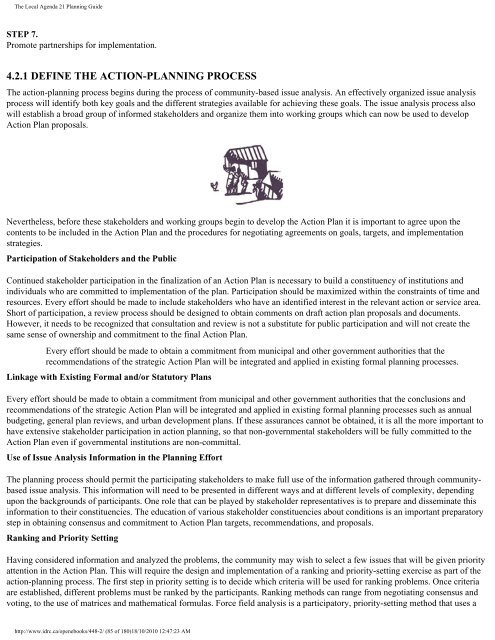The Local Agenda 21 Planning Guide - Democrats Against UN ...
The Local Agenda 21 Planning Guide - Democrats Against UN ...
The Local Agenda 21 Planning Guide - Democrats Against UN ...
You also want an ePaper? Increase the reach of your titles
YUMPU automatically turns print PDFs into web optimized ePapers that Google loves.
<strong>The</strong> <strong>Local</strong> <strong>Agenda</strong> <strong>21</strong> <strong>Planning</strong> <strong>Guide</strong><br />
STEP 7.<br />
Promote partnerships for implementation.<br />
4.2.1 DEFINE THE ACTION-PLANNING PROCESS<br />
<strong>The</strong> action-planning process begins during the process of community-based issue analysis. An effectively organized issue analysis<br />
process will identify both key goals and the different strategies available for achieving these goals. <strong>The</strong> issue analysis process also<br />
will establish a broad group of informed stakeholders and organize them into working groups which can now be used to develop<br />
Action Plan proposals.<br />
Nevertheless, before these stakeholders and working groups begin to develop the Action Plan it is important to agree upon the<br />
contents to be included in the Action Plan and the procedures for negotiating agreements on goals, targets, and implementation<br />
strategies.<br />
Participation of Stakeholders and the Public<br />
Continued stakeholder participation in the finalization of an Action Plan is necessary to build a constituency of institutions and<br />
individuals who are committed to implementation of the plan. Participation should be maximized within the constraints of time and<br />
resources. Every effort should be made to include stakeholders who have an identified interest in the relevant action or service area.<br />
Short of participation, a review process should be designed to obtain comments on draft action plan proposals and documents.<br />
However, it needs to be recognized that consultation and review is not a substitute for public participation and will not create the<br />
same sense of ownership and commitment to the final Action Plan.<br />
Every effort should be made to obtain a commitment from municipal and other government authorities that the<br />
recommendations of the strategic Action Plan will be integrated and applied in existing formal planning processes.<br />
Linkage with Existing Formal and/or Statutory Plans<br />
Every effort should be made to obtain a commitment from municipal and other government authorities that the conclusions and<br />
recommendations of the strategic Action Plan will be integrated and applied in existing formal planning processes such as annual<br />
budgeting, general plan reviews, and urban development plans. If these assurances cannot be obtained, it is all the more important to<br />
have extensive stakeholder participation in action planning, so that non-governmental stakeholders will be fully committed to the<br />
Action Plan even if governmental institutions are non-committal.<br />
Use of Issue Analysis Information in the <strong>Planning</strong> Effort<br />
<strong>The</strong> planning process should permit the participating stakeholders to make full use of the information gathered through communitybased<br />
issue analysis. This information will need to be presented in different ways and at different levels of complexity, depending<br />
upon the backgrounds of participants. One role that can be played by stakeholder representatives is to prepare and disseminate this<br />
information to their constituencies. <strong>The</strong> education of various stakeholder constituencies about conditions is an important preparatory<br />
step in obtaining consensus and commitment to Action Plan targets, recommendations, and proposals.<br />
Ranking and Priority Setting<br />
Having considered information and analyzed the problems, the community may wish to select a few issues that will be given priority<br />
attention in the Action Plan. This will require the design and implementation of a ranking and priority-setting exercise as part of the<br />
action-planning process. <strong>The</strong> first step in priority setting is to decide which criteria will be used for ranking problems. Once criteria<br />
are established, different problems must be ranked by the participants. Ranking methods can range from negotiating consensus and<br />
voting, to the use of matrices and mathematical formulas. Force field analysis is a participatory, priority-setting method that uses a<br />
http://www.idrc.ca/openebooks/448-2/ (85 of 180)18/10/2010 12:47:23 AM










